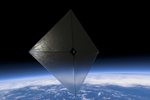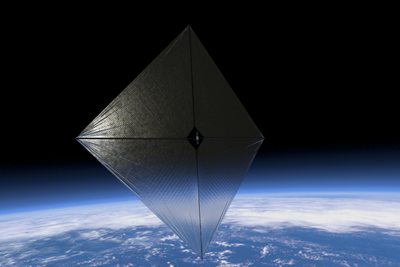Three companies chosen to advance NASA deployable solar array
Astrobotic Technology, Lockheed Martin and Honeybee Robotics awarded $19.4 million to prototype build and test solar array systems to power moon exploration under Artemis. Current mast designs incorporate carbon fiber-based technologies.
Vertical solar arrays, pictured in this illustration, will help power exploration of the moon under Artemis. Photo Credit: NASA
NASA (Washington, D.C., U.S.) has selected three companies to further advance work on deployable solar array systems that will help power the agency’s human and robotic exploration of the moon under Artemis (updates on the Artemis I first uncrewed flight).
Through Artemis missions, NASA expects to return humans to the moon and establish a long-term presence near the lunar South Pole. A reliable, sustainable power source is required to support lunar habitats, rovers and even construction systems for future robotic and crewed missions. To help provide this power, NASA is supporting development of vertical solar arrays that can autonomously deploy up to 32 feet high and retract for relocation if necessary.
“These prototypes will provide promising solutions for reliable power sources on the moon, which are key to the success of almost anything we do on the surface,” Niki Werkheiser, director of technology maturation in NASA’s Space Technology Mission Directorate (STMD) at NASA headquarters in Washington, says. “This effort plays a critical role that will quite literally help power our Artemis exploration in the uniquely challenging environment of the moon’s South Pole.”
The agency has awarded a total of $19.4 million to three companies to build prototypes and perform environmental testing, with the goal of deploying one of the systems near the moon’s South Pole near the end of this decade. The designs must remain stable on sloped terrain and be resistant to abrasive lunar dust, all while minimizing both mass and stowed volume to aid in the system’s delivery to the lunar surface. The awards include:
- Astrobotic Technology (Pittsburgh, Penn., U.S.): $6.2 million
- Honeybee Robotics (Brooklyn, N.Y., U.S.): $7 million
- Lockheed Martin (Littleton, Colo., U.S.): $6.2 million
According to NASA, two out of three of these vendor designs (Astrobotic and Lockheed Martin) incorporate carbon fiber-based technologies for the masts.
Existing space-rated solar array structures are designed for use in microgravity or for horizontal surface deployment. The vertical orientation and height of these new designs will help prevent loss of power at the lunar poles where the sun does not rise very far above the horizon, according to NASA. When the sun is low on the horizon, the moon’s terrain can block some of its light, keeping it from reaching solar arrays that are low to the ground. By placing the solar arrays on tall masts, these designs enable uninterrupted light and therefore produce more power.
“We are excited to be able to select these three teams as they all bring very different technological solutions as well as unique visions for how commercial space can support a sustained presence on the moon,” says Chuck Taylor, Vertical Solar Array Technology (VSAT) project manager at NASA’s Langley Research Center (Hampton, Va., U.S.).
The contracts are part of the agency’s VSAT project, which aims to support NASA’s long-term lunar surface operations. In 2021, NASA selected five companies to create initial designs for vertical solar array technologies. VSAT is led by STMD’s Game Changing Development program and Langley in collaboration with NASA’s Glenn Research Center in Cleveland.
Related Content
Cryo-compressed hydrogen, the best solution for storage and refueling stations?
Cryomotive’s CRYOGAS solution claims the highest storage density, lowest refueling cost and widest operating range without H2 losses while using one-fifth the carbon fiber required in compressed gas tanks.
Read MoreThe state of recycled carbon fiber
As the need for carbon fiber rises, can recycling fill the gap?
Read MoreThe making of carbon fiber
A look at the process by which precursor becomes carbon fiber through a careful (and mostly proprietary) manipulation of temperature and tension.
Read MoreMaterials & Processes: Fibers for composites
The structural properties of composite materials are derived primarily from the fiber reinforcement. Fiber types, their manufacture, their uses and the end-market applications in which they find most use are described.
Read MoreRead Next
NASA develops advanced composite solar sail system
The ACS3 mission expects to demonstrate the successful deployment of the composite boom solar sail in low-Earth orbit to guide the design of future, larger-scale composite solar sail systems.
Read MoreCW’s 2024 Top Shops survey offers new approach to benchmarking
Respondents that complete the survey by April 30, 2024, have the chance to be recognized as an honoree.
Read MoreFrom the CW Archives: The tale of the thermoplastic cryotank
In 2006, guest columnist Bob Hartunian related the story of his efforts two decades prior, while at McDonnell Douglas, to develop a thermoplastic composite crytank for hydrogen storage. He learned a lot of lessons.
Read More



























